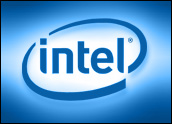
Intel unveiled several new Atom processors on Monday. The chips are smaller and more energy-efficient than their predecessors. They also integrate graphics processors (GPUs) and memory controllers into the CPUs.
Two of them are single-core processors and the third is a dual-core CPU. All run at 1.66 GHz. Computers based on these new processors will be available Jan. 4, 2010.
Shrinking the Atom
Intel’s new line of Atom processors consists of products for netbooks and entry-level desktop PCs. For netbooks, Intel unveiled the N450 processor. For desktop PCs, Intel announced the D410 and the D510, the only dual-core processor in the latest lineup. All three are paired with the new low-power NM10 Express Chipset, which was also announced on Monday.
Intel claims the integration of memory controllers and graphics into the CPU in the new line of Atom processors is an industry first on x86 chips. This means the processors now consist of a CPU and a chipset. They don’t need an input/output controller hub like older-generation chips did.
The N450 offers a 20 percent improvement in average power consumption, Intel said. The integration has cut the total footprint for the netbook platform by about 60 percent, according to the company. For entry-level desktop PCs based on the new Intel Atoms, the reduction is about 70 percent.
The Nitty-Gritty Tech Info
The N450 is a single-core processor with 512 KB of L2 cache and a 7-watt total kit TDP, including the chipset. TDP stands for “thermal design power.” It’s the maximum amount of power a chip will draw when running real applications and represents the maximum amount of power the cooling system in a computer has to dissipate.
The D410 is a single-core Atom processor for entry-level desktop PCs. It has 512 KB of L2 cache and 12 watts of total kit TDP, including the chipset. The D510 is the only dual-core processor unveiled on Monday. It’s for entry-level desktop PCs and has 1 MB of L2 cache. It has a 15-watt total kit TDP, including the chipset.
All three processors run at 1.66 MHz. Pricing and availability will be announced in January.
The smaller processors with their lower power consumption rates may make for new, super-small fanless and all-in-one desktops, Intel spokesperson Bill Calder said..
Battling the Competition
Asus, Acer, Lenovo, Dell, Toshiba, Samsung and Fujitsu are among the vendors coming out with products based on the new Atom line, Intel said. Most of the new systems will run on Windows 7 Starter or Windows 7 Home Basic, but some vendors will offer Moblin Linux v2, Intel’s version of Linux, as well.
The netbook line is expected to be very hot — Gartner predicts that worldwide PC shipments will grow, driven by increasing mobile PC shipments. This year, mobile PC shipments will probably hit 162 million units, and in 2010, they are expected to total more than 196 million units, Gartner forecast.
That has led to expectations of strong sales, which in turn are pulling chip vendors into the market for mobile computing chips. This could cause Intel a headache. “The big problem for Intel is ARM and the massed number of companies, ranging from Marvell and Qualcomm to Nvidia and Freescale, that are suddenly focused on this emerging segment of small personal products,” Rob Enderle, principal analyst at the Enderle Group, told TechNewsWorld.
Many of these vendors have a strong presence in the GPU side of the business, which seems to be gaining ground at the CPU’s expense, Enderle pointed out. For example, the Oak Ridge National Laboratory, the Department of Energy’s largest science and energy lab, plans to build a new supercomputer based on the next-generation “Fermi” CUDA graphics processing unit Nvidia announced recently.
Intel’s traditional weakness in the graphics sector is going to hurt it in the battle for GPU dominance, Enderle said. “While Intel’s much larger and more powerful than AMD or Nvidia, and has the x86 base behind it, it’s much weaker, comparatively, in this battle than it is on the regular PC platform,” he explained. “There is a much more even playing field here.”
For example, Intel recently had to put its plans for its Larrabee graphics processor on hold indefinitely, just one month after setting a new processing speed record with that chip. Intel now plans to use Larrabee technology as a software development platform for internal and external use in high-performance computing.
However, Intel’s new Atom line is a different kettle of fish, company spokesperson Calder pointed out. “Larrabee was an entirely different focus, which is discrete graphics,” he told TechNewsWorld. “With this segment, we’ve integrated graphics directly into the CPU. That’s not anything like Larrabee.”
The competition does not pose much of a threat, Calder said. “We have a year-and-a-half lead in sales of silicon for netbooks,” he said. “We’ve heard a lot about various competing designs, but today you can’t buy anything in terms of significant numbers from other suppliers.”
Footfalls of the FTC
Intel’s integration of GPUs into CPUs in its new Atom line is being dogged by questions about the lawsuit filed recently by the FTC against Intel alleging anticompetitive behavior.
Could this pending lawsuit impact sales of the new Atom chips? Intel doesn’t think so. “The integration of graphics and memory controllers into the CPU is a function of Moore’s law,” Calder explained. “As we continue to shrink transistors and the overall real estate of silicon, we’re able to put more and more features on the chips themselves. That’s what we do as a company — we innovate and integrate.”
However, analyst Enderle contends the FTC lawsuit could still be a thorn in Intel’s side. “Much like Microsoft was forced to change behavior by the European Commission, Intel could be forced to open up its technology more by the FTC,” he said. “It will be a very interesting year in 2010 for Intel, but not necessarily in the best possible way.”





















































